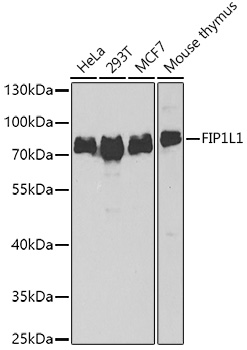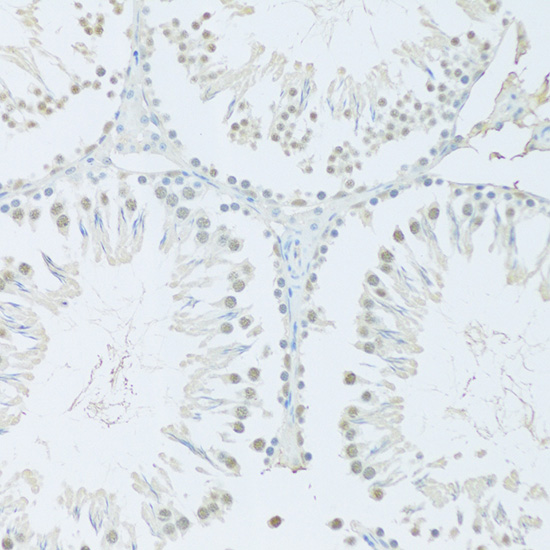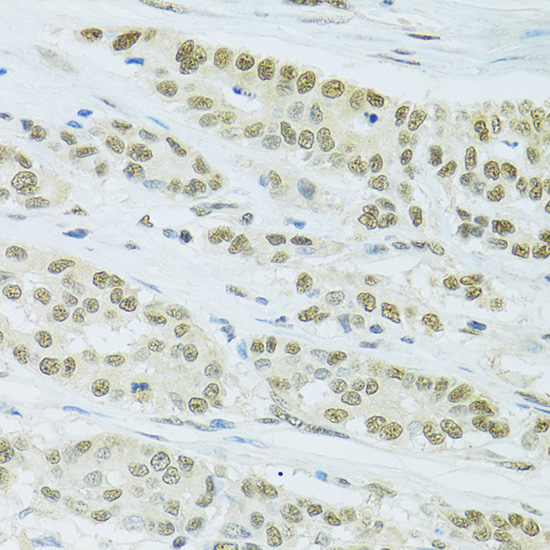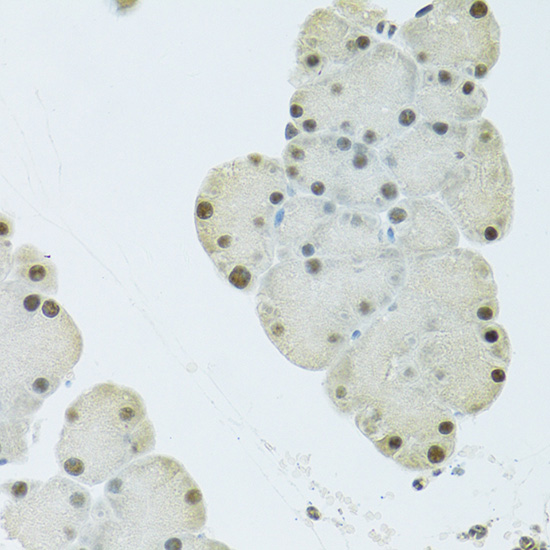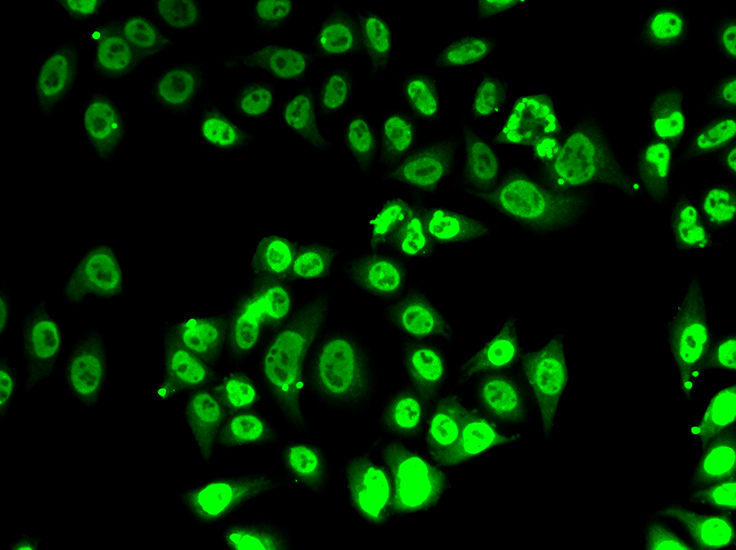ChIP Antibodies
Anti-FIP1L1 Antibody (CAB7138)
- SKU:
- CAB7138
- Product Type:
- Antibody
- Reactivity:
- Human
- Reactivity:
- Mouse
- Reactivity:
- Rat
- Host Species:
- Rabbit
- Isotype:
- IgG
- Antibody Type:
- Polyclonal Antibody
- Research Area:
- Epigenetics and Nuclear Signaling
Description
| Antibody Name: | Anti-FIP1L1 Antibody |
| Antibody SKU: | CAB7138 |
| Antibody Size: | 20uL, 50uL, 100uL |
| Application: | WB IHC IF |
| Reactivity: | Human, Mouse, Rat |
| Host Species: | Rabbit |
| Immunogen: | Recombinant fusion protein containing a sequence corresponding to amino acids 1-300 of human FIP1L1 (NP_001128409.1). |
| Application: | WB IHC IF |
| Recommended Dilution: | WB 1:500 - 1:2000 IHC 1:50 - 1:200 IF 1:50 - 1:100 |
| Reactivity: | Human, Mouse, Rat |
| Positive Samples: | HeLa, 293T, MCF7, Mouse thymus |
| Immunogen: | Recombinant fusion protein containing a sequence corresponding to amino acids 1-300 of human FIP1L1 (NP_001128409.1). |
| Purification Method: | Affinity purification |
| Storage Buffer: | Store at -20'C. Avoid freeze / thaw cycles. Buffer: PBS with 0.02% sodium azide, 50% glycerol, pH7.3. |
| Isotype: | IgG |
| Sequence: | MSAG EVER LVSE LSGG TGGD EEEE WLYG DENE VERP EEEN ASAN PPSG IEDE TAEN GVPK PKVT ETED DSDS DSDD DEDD VHVT IGDI KTGA PQYG SYGT APVN LNIK TGGR VYGT TGTK VKGV DLDA PGSI NGVP LLEV DLDS FEDK PWRK PGAD LSDY FNYG FNED TWKA YCEK QKRI RMGL EVIP VTST TNKI TAED CTME VTPG AEIQ DGRF NLFK VQQG RTGN SEKE TALP STKA EFTS PPSL FKTG LPPS RNST SSQS QTST ASRK ANSS VGKW QDRY GRAE SPDL RRLP GAID |
| Gene ID: | 81608 |
| Uniprot: | Q6UN15 |
| Cellular Location: | Nucleus |
| Calculated MW: | 40kDa/58kDa/65kDa/66kDa |
| Observed MW: | 80kDa |
| Synonyms: | FIP1L1, FIP1, Rhe, hFip1 |
| Background: | This gene encodes a subunit of the CPSF (cleavage and polyadenylation specificity factor) complex that polyadenylates the 3' end of mRNA precursors. This gene, the homolog of yeast Fip1 (factor interacting with PAP), binds to U-rich sequences of pre-mRNA and stimulates poly(A) polymerase activity. Its N-terminus contains a PAP-binding site and its C-terminus an RNA-binding domain. An interstitial chromosomal deletion on 4q12 creates an in-frame fusion of human genes FIP1L1 and PDGFRA (platelet-derived growth factor receptor, alpha). The FIP1L1-PDGFRA fusion gene encodes a constitutively activated tyrosine kinase that joins the first 233 amino acids of FIP1L1 to the last 523 amino acids of PDGFRA. This gene fusion and chromosomal deletion is the cause of some forms of idiopathic hypereosinophilic syndrome (HES). This syndrome, recently reclassified as chronic eosinophilic leukemia (CEL), is responsive to treatment with tyrosine kinase inhibitors. Alternative splicing results in multiple transcript variants encoding distinct isoforms. |
| UniProt Protein Function: | FIP1L1: a component of the cleavage and polyadenylation specificity factor (CPSF) complex that plays a key role in pre- mRNA 3'-end formation, recognizing the AAUAAA signal sequence and interacting with poly(A) polymerase and other factors to bring about cleavage and poly(A) addition. FIP1L1 contributes to poly(A) site recognition and stimulates poly(A) addition. Binds to U-rich RNA sequence elements surrounding the poly(A) site. May act to tether poly(A) polymerase to the CPSF complex. A fusion of FIP1L1 and PDGFRA (FIP1L1-PDGFRA) is the cause of some cases of hypereosinophilic syndrome (HES), a disorder characterized by overproduction of eosinophils in the bone marrow, eosinophilia, tissue infiltration and organ damage. Four alternatively spliced isoforms have been described. |
| UniProt Protein Details: | Protein type:RNA processing; RNA-binding Chromosomal Location of Human Ortholog: 4q12 Cellular Component: nucleoplasm; mRNA cleavage and polyadenylation specificity factor complex Biological Process: mRNA processing Disease: Hypereosinophilic Syndrome, Idiopathic |
| NCBI Summary: | This gene encodes a subunit of the CPSF (cleavage and polyadenylation specificity factor) complex that polyadenylates the 3' end of mRNA precursors. This gene, the homolog of yeast Fip1 (factor interacting with PAP), binds to U-rich sequences of pre-mRNA and stimulates poly(A) polymerase activity. Its N-terminus contains a PAP-binding site and its C-terminus an RNA-binding domain. An interstitial chromosomal deletion on 4q12 creates an in-frame fusion of human genes FIP1L1 and PDGFRA (platelet-derived growth factor receptor, alpha). The FIP1L1-PDGFRA fusion gene encodes a constitutively activated tyrosine kinase that joins the first 233 amino acids of FIP1L1 to the last 523 amino acids of PDGFRA. This gene fusion and chromosomal deletion is the cause of some forms of idiopathic hypereosinophilic syndrome (HES). This syndrome, recently reclassified as chronic eosinophilic leukemia (CEL), is responsive to treatment with tyrosine kinase inhibitors. Alternative splicing results in multiple transcript variants encoding distinct isoforms. [provided by RefSeq, Oct 2008] |
| UniProt Code: | Q6UN15 |
| NCBI GenInfo Identifier: | 74749365 |
| NCBI Gene ID: | 81608 |
| NCBI Accession: | Q6UN15.1 |
| UniProt Related Accession: | Q6UN15 |
| Molecular Weight: | 75kDa |
| NCBI Full Name: | Pre-mRNA 3'-end-processing factor FIP1 |
| NCBI Synonym Full Names: | factor interacting with PAPOLA and CPSF1 |
| NCBI Official Symbol: | FIP1L1 |
| NCBI Official Synonym Symbols: | Rhe; FIP1; hFip1 |
| NCBI Protein Information: | pre-mRNA 3'-end-processing factor FIP1 |
| UniProt Protein Name: | Pre-mRNA 3'-end-processing factor FIP1 |
| UniProt Synonym Protein Names: | FIP1-like 1 protein; Factor interacting with PAP; Rearranged in hypereosinophilia |
| Protein Family: | Pre-mRNA 3'-end-processing factor |
| UniProt Gene Name: | FIP1L1 |
| UniProt Entry Name: | FIP1_HUMAN |
View AllClose


